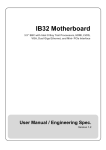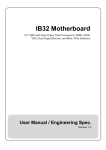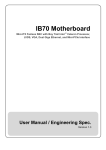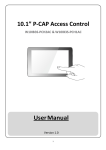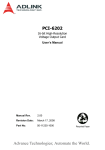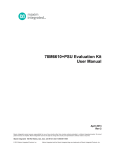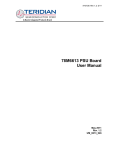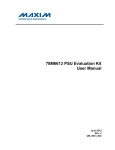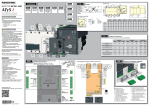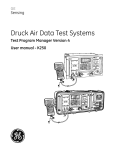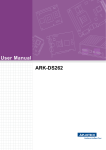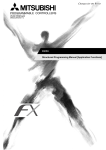Download IBDRW User Manual V1.0
Transcript
DIN Rail Box PC Intel Celeron Bay Trail-M IBDRW / IBDRW-Ex User Manual Version 1.0 Contents CHAPTER 1 WINMATE IBDRW / IBDRW-EX OVERVIEW ............................ 4 1.1 Introduction.................................................................................................4 1.2 Hardware Specification ...............................................................................4 1.2.1 System Specification..............................................................................4 1.2.2 Mechanical and Power...........................................................................4 1.2.3 I/O Connectors.......................................................................................5 1.2.4 Environment Considerations..................................................................5 1.3 Packing List ................................................................................................5 1.4 Safety Precaution .......................................................................................5 1.5 Chassis Dimension.....................................................................................7 CHAPTER 2 HARDWARE FUNCTIONALITY ................................................ 8 2.1 Winmate IBDRW / IBDRW-Ex Peripherals..................................................8 2.1.1 DC Adapter Jack....................................................................................8 2.1.2 DC Adapter Jack....................................................................................8 2.1.3 Panel .....................................................................................................9 2.1.4 DVI Connector .......................................................................................9 2.1.5 Mini PCIe ...............................................................................................9 2.1.6 SSD .....................................................................................................10 2.1.7 USB 2.0 + USB 3.0 + LAN Connector..................................................10 2.1.8 Dual LAN .............................................................................................11 2.1.9 COM + VGA.........................................................................................11 2.1.10 Audio ...................................................................................................12 2.1.11 DIDO ...................................................................................................12 2.1.12 RS422, RS485.....................................................................................12 2.1.13 Isolator DIDO (CON4)..........................................................................13 2.1.14 Clear CMOS ........................................................................................13 2.1.15 RS422, RS485 Terminal Resistor.........................................................13 2.1.16 RS422, RS485.....................................................................................13 2.1.17 RS232, RS422, RS485 ........................................................................14 CHAPTER 3 INITIAL SETUP........................................................................ 15 3.1 DIN Rail Mounting Setup ..........................................................................15 3.2 Cable ARM Bracket Installation (optional for IBDR-Ex) .............................16 3.3 Configuration of the BIOS.........................................................................17 3.3.1 BIOS setup and Boot Procedure..........................................................17 3.3.2 BIOS Setup Keys.................................................................................17 2 3.3.3 MAIN ...................................................................................................18 3.3.4 BIOS Advance Setup Utility..................................................................19 3.3.5 Advanced.............................................................................................20 3.3.6 USB Configuration ...............................................................................21 3.3.7 Chipset ................................................................................................23 3.3.8 Chipset North Bridge Parameters ........................................................23 3.3.9 Chipset South Bridge Parameters........................................................24 3.3.10 Security ...............................................................................................25 3.3.11 Security Boot Menu .............................................................................27 3.3.12 Boot .....................................................................................................28 3.3.13 Save & Exit ..........................................................................................29 APPENDIX.................................................................................................... 31 3 Chapter 1 Winmate IBDRW / IBDRW-Ex Overview 1.1 Introduction Winmate IBDRW is a DIN-rail mounted Fanless Box PC, which provides several serial communication ports. With a compact size and small form factor as well as front accessible I/Os, Winmate IBDR is very convenient for wiring and DIN-rail installation in the control cabinet. The Wide operation temperature and Industrial serial port design makes this unit a perfect communication even in harsh and critical location. While IBDRW-Ex is ATEX and Class 1 Division 2 certified DIN Rail Box pc for hazardous location deployment and for ATEX certified Box PC requires special enclosure box. 1.2 Hardware Specification 1.2.1 System Specification Processor : Intel ®Celeron ® Bay Trail-M System Chipset : Bay Trail SoC Chipset System Memory : 1 x DDR3L 1333MHz SO-DIMM 2GB (max 8GB) Ethernet Controller : 4 x Intel ®WG82574L GbE LAN USB : 1 x USB 3.0 : 3 x USB 2.0 (external) : 2 x USB 2.0 by pin-header (internal) Storage : Default 32GB mSATA SSD Second Storage (optional) : 2.5” SSD 64~512GB 1.2.2 Mechanical and Power Dimensions : 85.5mm x 152mm x 139mm (L x W x H) Construction : Aluminum Housing Power Input : 9-36V DC IN (isolation) Power Source Range : 20W max. Mounting : DIN Rail 4 1.2.3 I/O Connectors Front Side I/O : 1 x Power ON/OFF button with LED indicator 1 x Line Out, Line In, Mic In 4 x RJ-45 (Giga LAN) 1 x RS232 default (422/485 as optional) 1 x VGA 1 x USB3.0, 3 x USB2.0 1 x DC Power Terminal Block 1 x RS232 default (Isolated RS232/485 as optional) 1 x 20 pins terminal block DIDO 1.2.4 Environment Considerations Operating Temperature : -20 to 60 deg. C Operating Humidity : 5% to 95% (non condensing) Anti Vibration : 5Hz – 500Hz / 1 Grms / 3 Axis 1.3 Packing List • 1 x DIN Rail Mounting clip • 1 x User Manual • 1 x 12V AC to DC Power Adapter with power cord • 1 x System Recovery DVD (optional) • Terminal block female connectors • Cable Arm Bracket (Optional for IBDR-Ex) 1.4 Safety Precaution WARNING! Always completely disconnect the power cord from your chassis whenever you work with the hardware. Do not make connections while the power is on. Sensitive electronic components can be damaged by sudden power surges. Only experienced electronics personnel should open the PC chassis. 5 CAUTION! Always ground yourself to remove any static charge before touching the CPU card. Modern electronic devices are very sensitive to static electric charges. As a safety precaution, use a grounding wrist strap at all times. Place all electronic components in a static-dissipative surface or static-shielded bag when they are not in the chassis. SAFETY PRECAUTIONS! l Please read this safety instruction carefully. l Place keep this user’s manual for later reference. l Please disconnect this equipment for any AC outlet before cleaning. Use liquid or spray detergents for cleaning. Use a damp cloth. l Do not touch the LCD panel surface with sharp or hard objects. l For pluggable equipment, the power outlet must be installed near the equipment and must be easily accessible. l Keep this equipment away from humidity. l Place this equipment on a reliable surface during installation, dropping letting it fall could cause damage. l The openings on the enclosure are for air convection. Protect the equipment from overheating. DO NOT COVER THE OPENINGS. l Make sure the voltage of the power source is correct before connecting the equipment to the power outlet. l Position the power cord so that people cannot step on it. Do not place anything over the power cord. l All cautions and warnings on the equipment should be noted. l If the equipment is not used for a long time, disconnect it from the power source to avoid damage by transient over-voltage. l Never pour any liquid into an opening. This could cause fire or electrical shock. l Never open the equipment. For safety reasons, only qualified service personnel should open the equipment. l If any of the following situations arises, get the equipment check personnel: n The power cord or plug is damaged n Liquid has penetrated into the equipment n The equipment has been exposed to moisture n The equipment does not work well, or you cannot get it to work according to user’s manual n The equipment has been dropped and damaged n The equipment has obvious signs of breakage 6 l Do not leave this equipment in an uncontrolled environment where temperature is below -20oC (-4oF) or above 60oC (140oF). It may damage the equipment. l Caution – Use recommended mounting apparatus to avoid risk of injury. l Warning – Only use the connection cords which come along with the product, when in doubt, please contact the manufacturer. l Provision shall be made to provide transient protection device to be set at a level not exceeding 140% of the rated voltage at the power supply terminals of the apparatus. l Warning – Explosion Hazard – Do not disconnect equipment unless power has been switched off or the area is known to be non-hazardous. l Warning – The equipment should be adequately protected from direct light when installed indoor or outdoor. 1.5 Chassis Dimension 7 Chapter 2 Hardware Functionality 2.1 Winmate IBDRW / IBDRW-Ex Peripherals The following figures show the connectors on Winmate IBDRW and the following sections give you detailed information about function of each peripheral. 2.1.1 DC Adapter Jack Pin Signal Name 1 Adapter 2 GND 3 GND 4 GND 5 Adapter_DC 6 Adapter_DC 2.1.2 DC Adapter Jack Pin Signal Name Pin Signal Name 1 USB5V 12 TX2+ 2 USB- 13 TX2- 3 USB+ 14 TX3+ 4 GND 15 TX3- 5 USB5V 16 TX4+ 6 USB- 17 TX4- 7 USB+ 18 DGND 8 GND 19 LEDGND 9 NA 20 YLED 10 TX1+ 21 OLED 11 TX1- 22 GLED 2.1.3 Panel Pin Signal Name Pin Signal Name 1 +V5S 6 GND 2 +V3.3S 7 GND 3 GND 8 FP_RST_N 4 SATA_LED# 9 NA 5 PWRBTN# 10 +V5A Pin Signal Name Pin Signal Name 1 GND 10 GND 2 HDMIB_TMDS0- 11 HDMIB_TMDS2 - 3 HDMIB_TMDS0+ 12 HDMIB_TMDS2 + 4 GND 13 GND 5 HDMI_DDC_CLK 14 HDMIB_CLK + 6 HDMI_DDC_DATA 15 HDMIB_CLK - 7 GND 16 HDMI_HPD1 8 HDMIB_TMDS1- 17 +V5S 9 HDMIB_TMDS1+ 18 +V5S 2.1.4 DVI Connector 2.1.5 Mini PCIe 9 2.1.6 SSD 2.1.7 USB 2.0 + USB 3.0 + LAN Connector Pin Signal Name Pin Signal Name 1 +5VUSB3.0 20 LAN1_MDI0_IN+ 2 U2DN0 21 LAN1_MDI0_IN- 3 U2DP0 22 LAN1_MDI1_IN+ 4 UGND 23 LAN1_MDI1_IN- 5 U3RXDN1 24 LAN1_MDI2_IN+ 6 U3RXDP1 25 LAN1_MDI2_IN- 7 UGND 26 LAN1_MDI3_IN+ 8 U3TXDN1 27 LAN1_MDI3_IN- 9 U3TXDP1 28 LAN1_DGND 10 +5VUSB3.0 29 LAN1_VDD33 11 U2DN1 30 LAN1_ACTIVE_Y 12 U2DP1 31 LAN1_1000_O 13 UGND 32 LAN1_100_10_G 19 N89607501 10 2.1.8 Dual LAN Pin Signal Name Pin Signal Name 1 LAN3_MDI0_IN+ 19 NA 2 LAN3_MDI0_IN- 20 GND 3 LAN3_MDI1_IN+ 21 LAN3_100_10_G 4 LAN3_MDI1_IN- 22 LAN3_1000_O 5 LAN3_MDI2_IN+ 23 LAN3_ACTIVE_Y 6 LAN3_MDI2_IN- 24 LAN3_VDD33 7 LAN3_MDI3_IN+ 25 LAN4_100_10_G 8 LAN3_MDI3_IN- 26 LAN4_1000_O 9 NA 27 LAN4_ACTIVE_Y 10 GND 28 LAN4_VDD33 11 LAN4_MDI0_IN+ 29 LAN_GND 12 LAN4_MDI0_IN- 30 LAN_GND 13 LAN4_MDI1_IN+ 31 LAN_GND 14 LAN4_MDI1_IN- 32 NA 15 LAN4_MDI2_IN+ 33 LAN_GND 16 LAN4_MDI2_IN- 34 LAN_GND 17 LAN4_MDI3_IN+ 35 LAN_GND 18 LAN4_MDI3_IN- 36 NA 2.1.9 COM + VGA Pin Signal Name Pin Signal Name C1 DCD4/485TXRX- V1 R_FILTER C2 SRD4/485TXRX+ V2 G_FILTER C3 STD4/422RX+ V3 B_FILTER C4 DTR4/422RX- V4 NA C5 GND V5 GND C6 NDSR1 V6 GND C7 NRTS1 V7 GND C8 NCTS1 V8 GND C9 NRI1 V9 VGA_5V V10 GND 11 2.1.10 Audio Pin Signal Name Pin Signal Name A1 Line1_L C1 MIC1_L A2 SW_C C2 SW_B A3 AUGND C3 AUGND A4 LINE1_R C4 MIC1_R B1 AZ_FOUT_L G1 AUGND B2 LINE2_JD G2 AUGND B3 AUGND G3 AUGND B4 AZ_FOUT_R G4 AUGND C0 AUGND A1 LINE1_L A2 SW_C 2.1.11 DIDO Pin Signal Name Pin Signal Name 1 GND 8 DINT1 2 DIO_5V 9 DINT2 3 DOUT3 10 DINT0 4 DOUT1 11 GPIO53_IN0 5 DOUT2 12 GPIO56_OUT0 6 DOUT0 13 GPIO54_IN1 7 DINT3 14 GPIO57_OUT1 2.1.12 RS422, RS485 Pin Signal Name Pin Signal Name 1 GND 8 DINT1 2 DIO_5V 9 DINT2 3 DOUT3 10 DINT0 4 DOUT1 11 GPIO53_IN0 5 DOUT2 12 GPIO56_OUT0 12 2.1.13 Isolator DIDO (CON4) Pin Signal Name Pin Signal Name 1 ISO5V 6 DO2_GPIO 2 ISOGND 7 DI3_GPIO 3 DI1_GPIO 8 DO3_GPIO 4 DO1_GPIO 9 DI4_GPIO 5 DI2_GPIO 10 DO4_GPIO 2.1.14 Clear CMOS 1-2 : Clear CMOS 2-3 : Normal 2.1.15 RS422, RS485 Terminal Resistor 1-2 : 120 ohm 2.1.16 RS422, RS485 1-2 : RS485 2-3 : RS422 13 2.1.17 RS232, RS422, RS485 Jumper RS232 RS422 RS485 JP8 (2x3) 1-2 3-4 5-6 1-2 2-3 2-3 4-5 5-6 5-6 7-8 8-9 8-9 10-11 11-12 11-12 JP9 (3x4) 14 Chapter 3 Initial Setup 3.1 DIN Rail Mounting Setup Please follow these steps to mount the IBDRW hook kit on a DIN rail 1. Screw the provided DIN-rail Kit on the rear side of the box as the diagram shown below. 2. Please make sure the stiff metal handle part is located on the top 3. Press the stiff metal handle downward and insert the hook into the DIN-rail 4. Release the handle so it can snap into place as shown below 15 3.2 Cable ARM Bracket Installation (optional for IBDR-Ex) In hazardous locations, sparks caused by the movement from a cable and connector which is even slightly loose could lead to a disaster and to prevent this, cable arm bracket can be use to secure some LAN, USB and Audio connectors. Follow these steps to complete the installation 1. Find the cable arm bracket in the package, including the plate, bracket / holder, and screws 2. Install the plate on the top of the box and screw it tightly 3. Plug all the necessary cables into the connectors 4. Place the cable arm bracket according to the picture and then attach the bracket / holders to the plate and then screw it for securing the installed cables For ATEX deployment, it is require to have Enclosure box Note 16 3.3 Configuration of the BIOS 3.3.1 BIOS setup and Boot Procedure BIOS stands for “Basic Input Output System” and it is the most basic communication between user and the hardware. To enter BIOS Setup, the [DEL] key must be pressed after the USB controller has been initialized as soon as the following message appears on the monitor during Power On Self Test (POST): “Press DEL to run SETUP” Note : Update BIOS version may be published after the manual is released. Please check with the latest version of BIOS on the website. User may need to run BIOS setup utility for the following status: 1. Error message on screen indicate to check BIOS Setup 2. Restoring the Factory default setting 3. Modifing the specific hardware specification 4. Want to optimize the specification 3.3.2 BIOS Setup Keys The following keys are enabled during POST: Key Function Del Enters the BIOS setup menu Display the boot menu. Lists all bootable devices that are F7 connected to the system. With cursor ↑ and cursor ↓ and by pressing <ENTER>, select the device used for the boot Pause Pressing the [Pause] key stops the POST. Press any other key to resume the POST. The following keys can be used after entering the BIOS Setup: Key Function F1 General Help F2 Previous Values 17 F3 Optimized Defaults F4 Save & Exit Esc Exit +/- Change Opt. Enter Select or execute command Cursor ↑ Moves to the previous item Cursor ↓ Goes to the next item Cursor ← Moves to the previous item Cursor → Goes to the next item 3.3.3 MAIN Immediately after the [DEL] key is pressed during startup, the main BIOS setup menu appears: 18 BIOS setting Description Setting options Effect This is current time setting. The time is System Time maintained by the battery when the device Adjustment of the Set the time in the time format [hh:mm:ss] is turned off This is current date setting. The time is System Date maintained by the battery when the device Changes to the date Set the date in the format [mm/dd/yyyy] is turned off Set the language System Language This is current language Adjustment of the setting. language in other language. The language in this device is English 3.3.4 BIOS Advance Setup Utility BIOS Setting Intel AMT Support Intel AMT Setup Prompt Description Enable and disable BIOS support for Intel Active Management Technology Enable and disable the boot interruption <Ctrl+P> to call up Intel Management Engine BIOS Extention (MBEx) configuration page Enable Client Initiated Remote Access (CIRA) Fast Call for Help. AMT CIRA Request Trig CIRA allows AMT maintenance event if the AMT PC is not in the intranet AMT CIRA Timeout Un-Configure ME USB Configure CIRA timeout for connection establishment with MPS (Manageability Presence Server / “vPro Enabled Gateway”) Resets all the values of the MEBx to their defaults (see section “Reset with Un-Configure”) USB Configure: Enable and disable the USB configuration (provisioning) 19 3.3.5 Advanced BIOS Setting Description Setting Effect options ACPI Settings Configures ACPI settings Enter SMART Settings Configures SMART settings Enter Super IO Configuration Configures System Super IO Chip parameters Enter Hardware Monitor Monitor hardware status Enter CPU Configuration Configures CPU settings Enter PPM Configuration Configures PPM Parameters Enter Thermal Configuration IDE Configuration Configures Thermal Parameters Configures IDE devices 20 Enter Enter Opens submenu Opens submenu Opens submenu Opens submenu Opens submenu Opens submenu Opens submenu Opens submenu LPSS & SCC Configuration Network Stack Configuration Configures LPSS & SCC Enter Configures network stack Enter Configures CSM: CSM Configuration Enable/Disable, Option ROM Enter execution settings, etc. CMOS CMOS settings / Information Enter Trusting Computing Trusted computing settings Enter USB Configuration Configures USB settings Enter Platform Trust Technology Platform trust technology Enter Opens submenu Opens submenu Opens submenu Opens submenu Opens submenu Opens submenu Opens submenu 3.3.6 USB Configuration BIOS Setting Description Setting Effect options Legacy USB User can enable or Disable 21 will keep USB devices available only for EFI Support applications disable USB port Enable User can enable or USB 3.0 Support This is a workaround for OSes without XHCI hand-off support This is a workaround for EHCI Hand-off OSes without ECHI hand-off support USB mass User can Enable or storage driver disable USB mass support storage driver support USB Transfer time-out Device Reset time-out devices Enable USB 3.0 is enable Disable USB 3.0 is disable Disable Disables this function Enable Enables this function Disable Disables this function Enable Enables this function Disable Disables this function Enable Enables this function disable USB 3.0 (XHCI) controller support. XHCI Hand-off Enable all the USB 1 Sec The time-out value for control, bulk, and interrupt transfers 5 Sec Depends on the time-out 10 Sec value 20 Sec 10 Sec USB mass storage device start unit command time-out 20 Sec Depends on the time-out 30 Sec value 40 Sec Maximum time the Device power-up device will take before it delay properly reports itself to Uses default value: for a Auto the host controller root port it is 100 ms, for a Hub port the delay is taken from Hub descriptor 22 3.3.7 Chipset 3.3.8 Chipset North Bridge Parameters BIOS Setting Description Setting Effect options Intel IGD Configuration Provides onboard graphics-related 23 Enter Opens submenu configuration options IGD – LCD Control Graphic Power Management Control Configures IGD – LCD setting Enter Provides power saving configuration options for the Enter onboard graphics Opens submenu Opens submenu 3.3.9 Chipset South Bridge Parameters BIOS Setting Description Setting Effect options Azalia HD Audio Configures onboard audio Disable function Enable USB Configuration Provides user with configuration options for the USB 2.0(EHCI) USB controller, such as enabling/disabling a USB Port 0 specific USB port and support for certain features USB Port 1 USB Port 2 24 Disables this function Enables this function Enable / Disable this function Enable / Disable this function Enable / Disable this function Enable / Disable this function USB Port 3 Provides user with configuration options for the PCI Express Configuration PCI Express bus, such as enabling/disabling a specific PCI Express channel and speed configuration Configures high precision High Precision Timer this function PCI Express Enable / Disable port 0 this function PCI Express Enable / Disable port 1 this function PCI Express Enable / Disable port 2 this function PCI Express Enable / Disable port 3 this function Disable timer (HPET) in the operating system Enable / Disable Enable Disables this function Enables this function The System Power Off stays off upon the return of the AC power The System is Configures the state of the Restore AC Power Loss Power On system after return of power turned on upon the return of the AC power on AC power loss The system returns to its last Last State known awake state upon the return of the AC power Quite Serial IRQ Mode Configures IRQ mode Entering quite (active) mode Entering Continuous Continuous (idle) mode 3.3.10 Security Allows user to configure an administration or user password, user must enter the administrator or user password at system startup and when entering BIOS setup 25 BIOS Setting Description Setting Effect options Displays whether or not an Administrator Password administrator password has Enter Enter Password Enter Enter Password been set User Password Display whether or not a user password has been set 26 3.3.11 Security Boot Menu BIOS Setting Secure Boot Description Setting options Displays the current boot Disable state Enable Secure Boot Mode Allows user to configure Disable the secure boot mode Enable Effect Disables this function Enables this function Disables this function Enables this function Enroll all factory default keys, Platform Key Management Provides user with key, key exchange configuration options for key, Authorized Select the secure boot key signatures, desired key management Authorized timestamps, Forbidden signatures 27 3.3.12 Boot BIOS Setting Description Setting Effect options Allows user to configure the Setup Prompt Timeout number of seconds to stay in BIOS setup prompt Enter Set the prompt timeout screen Enables or disables On Remains On Off Remains Off Numlock feature on the Boot NumLock State numeric keypad of the keyboard after the POST. (Default: On) Determines if POST Quite Boot message or OEM logo (default = Black background) is displayed Enables or disables Fast Fast Boot Disabled Enabled Disable Boot to shorten the OS boot process. (Default: Disabled) 28 Enable Disables this function Enables this function Disables this function Enables this function Boot Option Priority Hard Drive BBS Priority Specifies the overall boot Ex: order from the available Boot Option#1 devices (hard drive) Hard drive as the first priority Specifies the boot order for Enter the a specific device type, such submenu that as hard drives, optical drives, floppy disk drives, present the Enter devices of the and devices that support same type are Boot from LAN function connected 3.3.13 Save & Exit BIOS Setting Description This saves the changes to Save Changes and Exit Setting options Enter <Yes> the CMOS and exits the BIOS Setup program Effect Saves the changes Return to the Esc <No> BIOS Setup Main Menu Discard Changes and Exit This exits the BIOS Setup without saving the changes 29 Enter <Yes> Saves the changes Return to the made in BIOS Setup to the CMOS Esc <No> BIOS Setup Main Menu Enter Save Changes and Reset <Yes> Reset the system after Saves the changes Return to the saving the changes Esc <No> BIOS Setup Main Menu Enter Discard Changes and Reset system setup without Reset saving any changes <Yes> Saves the changes Return to the Esc <No> BIOS Setup Main Menu Enter Save Changes <Yes> Save changes done so far Saves the changes Return to the to any of the setup options Esc <No> BIOS Setup Main Menu Discard changes done so Discard Changes Enter <Yes> far to any of the setup options Saves the changes Return to the Esc <No> BIOS Setup Main Menu Enter Restore Default <Yes> Restore/load default values Saves the changes Return to the for all the setup options Esc <No> BIOS Setup Main Menu Enter Save as User Defaults <Yes> Save the changes done so Saves the changes Return to the far as User defaults Esc <No> BIOS Setup Main Menu Enter Restore User Defaults <Yes> Restore the User Defaults to Saves the changes Return to the all the setup options Esc <No> BIOS Setup Main Menu 30 APPENDIX Refer the following descriptions for various approvals and certifications N.A. Safety for Information Technology Equipment (optional for IBDRW-Ex) Certification by Underwriter Laboratories to UL60950-1, 2nd Edition standard and equivalent CSA C22.2 No 60950-1-07, 2nd Edition Standard N.A. Safety for HazLoc Class 1 Division 2, Groups A,B,C,D,T4 (optional for IBDRW-Ex) Certification by Underwriter Laboratories to ANSI/ISA-12.12.01-2012 standard and equivalent CAN/CSA C22.2 No 213-M1987 Standard Explosive Atmosphere Directive (optional for IBDRW-Ex) Certification with ATEX Directive 94/9/EC; Independent 3rd party assessment Low Voltage Directive European Safety for Industrial Control Equipment Self-Declaration in accordance with European LVD Directive 2006/95/EC; Independent 3rd party assessment (Accredited by IEC 17025) Electromagnetic Compatibility Directive European EMC for Industrial Control Equipment Self-Declaration in accordance with EMC Directive 2004/108/EC; Independent 3rd party assessment (Accredited by IEC 17025) 31 Federal Communications Commission on electromagnetic interference This device complies with part 15 of the FCC Rules. Operation is subject to the following two conditions: (1) This device may cause harmful and (2) this device must accept any interference received, including that may cause undesired operation 32
































